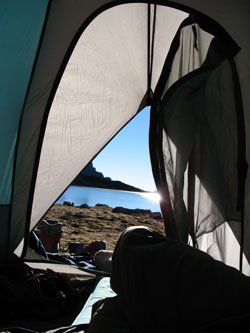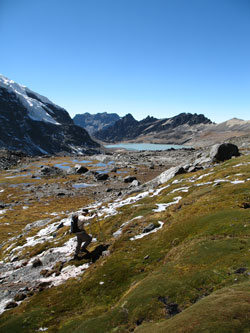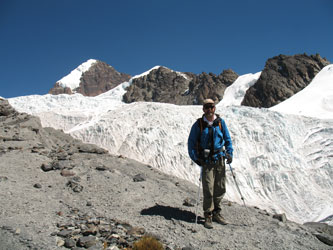-
Mt. Bierstadt Group Summit - Front Range, Colorado
-
A rest before the summit push on Dallas Peak - San Juan Range, Colorado
-
Broken Ankle + 6 Miles = Tired
-
The classic San Juan approach - San Juan Range, Colorado
-
Overlooking Noname Basin from Twin Thumbs Pass - San Juan Range, Colorado
-
Upper Noname Basin - San Juan Range, Colorado
-
Nearing Noname Cabin - San Juan Range, Colorado
-
Twin Thumbs Twins - San Juan Range, Colorado
-
Nearing the summit of Pt. 13,736 - Sawatch Range, Colorado
-
Blustery day on Iowa Peak - Sawatch Range, Colorado
-
Morning snow at 15k, Cerro Ramada - Cordillera Ramada
-
Artesonraju from the summit of Nevado Pisco - Cordillera Blanca, Peru
-
February crowds on Gray's Peak - Front Range, Colorado
-
Kicking steps on Cerro Lliani - Cordillera Vilcanota, Peru
-
Final traverse to the summit of Wheeler Mountain - Ten Mile Range, Colorado
-
The long walk to Pachanta - Cordillera Vilcanota, Peru
- banner31
Afternoon at 17k on Cerro Ramada - Cordillera Ramada, Argentina
- banner22
The final ridge on Iowa Peak - Sawatch Range, Colorado
-
Summer summit on Longs Peak - Front Range, Colorado
-
A rest day at the Pachanta Hot Springs - Cordillera Vilcanota, Peru
-
Mind over matter on Mt. Parnassas - Front Range, Colorado
-
Rest stop on Cerro Lliani - Cordillera Vilcanota, Peru
- banner30
Post nap surprise on Cerro Ramada - Cordiller Ramada, Argentina
-
Summit on Cerro Lliani - Cordillera Vilcanota, Peru
- banner23
Ridge walking on Grizzly Peak - Sawatch Range, Colorado
-
Enroute the summit via the West Ridge on Pacific Peak - Ten Mile Range, Colorado
-
Mule train bound for Chilca - Cordillera Vilcanota, Peru
-
Taking in the view from Fletcher Peak - Ten Mile Range, Colorado
-
Hiking on Silverheels - Mosquito Range, Colorado
-
Traversing! Gladstone Peak - San Juan Range, Colorado
- banner24
The best of times at Willow Lake - Sangre de Christo Range, Colorado
- banner29
High Altitude Cerebral Edema? - Cordillera Ramada, Argentina
-
Bound for Chilca - Vilcanota Range, Peru
-
Going alpine light, Holy Cross Ridge - Sawatch Range, Colorado
-
Cumbre! Campa I - Cordillera Vilcanota, Peru
-
Roadside lunch with the best of company - Cordillera Vilcanota, Peru
- banner25
Long ridge walk to the summit of California Peak - Sangre de Christo Range, Colorado
- banner28
Crossing el Rio Colorado . . . in the afternoon - Cordillera Ramada, Argentina
- banner37
Dealing with Fall snows high on Casco Peak - Sawatch Range, Colorado
-
Moonrise over Mercedario - Cordillera Ramada, Argentina
-
Still climbing at 20,900 on Cerro Ramada - Cordiller Ramada, Argentina
-
Talus on Halo Ridge, Mt. of the Holy Cross - Sawatch Range, Colorado
- banner26
Deteriorating conditions on Mt. Arkansas - Ten Mile Range, Colorado
- banner27
After the climb - Cordillera Ramada, Argentina
- banner38
Taking in the view from the summit of Crystal Peak - Tenmile Range, Colorado
-
Topping out on Mt. Arkansas' North Couloir - Mosquito Range, Colorado
-
Glissade on Mt. Arkansas - Mosquito Range, Colorado
-
Hard snow morning on Teakettle Mountain - San Juan Range, Colorado
-
Spring snow announces the start of the climb on Dallas Peak - San Juan Range, Colorado
-
Crossing the Eolus Catwalk - San Juan Range, Colorado

 The previous day's climb of Sunchuli gave us a viewpoint from which we could decide where climb after a rest day. From the summit, we could see Nevado Posnansky, the higher adjacent peak as well as Cololo, the primary landmark for this portion of the Apolobamba. We decided to take a shot at Posnansky but we could not see the entirely of the approach to the glacier nor the glacier beyond the crest closest to Sunchuli. To find a sure route for the next day we needed a rest day hike.
The previous day's climb of Sunchuli gave us a viewpoint from which we could decide where climb after a rest day. From the summit, we could see Nevado Posnansky, the higher adjacent peak as well as Cololo, the primary landmark for this portion of the Apolobamba. We decided to take a shot at Posnansky but we could not see the entirely of the approach to the glacier nor the glacier beyond the crest closest to Sunchuli. To find a sure route for the next day we needed a rest day hike. We ate a leisurely breakfast and then wandered off toward the Cololo glacier, knowing that there had to be a route up Posnansky via the spine of one of the two moraines, but we were unsure which would yield the best course. We wandered across the base of the valley, aiming for huge boulder that we planned to mark on my GPS to allow for a 0 dark thirty approach to the same point the next morning. The course across the valley floor is a hopscotch affair as you first cross meltwater troughs and mushy moss pillows then you start hopping from boulder to boulder as you climb the sinuous terminus of the moraine.
We ate a leisurely breakfast and then wandered off toward the Cololo glacier, knowing that there had to be a route up Posnansky via the spine of one of the two moraines, but we were unsure which would yield the best course. We wandered across the base of the valley, aiming for huge boulder that we planned to mark on my GPS to allow for a 0 dark thirty approach to the same point the next morning. The course across the valley floor is a hopscotch affair as you first cross meltwater troughs and mushy moss pillows then you start hopping from boulder to boulder as you climb the sinuous terminus of the moraine.  These moraines are not like those we experienced on Pisco, they are not active dirty glaciers but quite stable and form a series of terraces that you hike up and over until you reach the spine of the Cololo glacier's lateral moraine. We climbed the lateral moraine and hiked perhaps half its length to gain a good view of the Posnansky approach and route. We saw that there were at least three different couloir routes, each of which would put you on the Posnansky's ice slope, just at a different point on the peak's curving west face. We were also able to see a bit more of the ice route but discerning the angle of the snow ridge we planned to climb was not really possible. Looked at from one point and it looked to have a 45 degree slope, shift a bit in another direction and it looked to steepen to 60 degrees. We had hunch that we would be looking at neve, based on our Sunchuli climb but Posnanski has a least one obvious crevasse, easily visible from the valley below, so weknew ice screws would have to be part of the gear load as well.
These moraines are not like those we experienced on Pisco, they are not active dirty glaciers but quite stable and form a series of terraces that you hike up and over until you reach the spine of the Cololo glacier's lateral moraine. We climbed the lateral moraine and hiked perhaps half its length to gain a good view of the Posnansky approach and route. We saw that there were at least three different couloir routes, each of which would put you on the Posnansky's ice slope, just at a different point on the peak's curving west face. We were also able to see a bit more of the ice route but discerning the angle of the snow ridge we planned to climb was not really possible. Looked at from one point and it looked to have a 45 degree slope, shift a bit in another direction and it looked to steepen to 60 degrees. We had hunch that we would be looking at neve, based on our Sunchuli climb but Posnanski has a least one obvious crevasse, easily visible from the valley below, so weknew ice screws would have to be part of the gear load as well. It was just a beautiful day, with only a light wind, until we stopped for lunch and to take in the view of Cololo and the surrounding peaks that can't be beat. We scoped out the potential routes on Cololo but more interesting were the routes that lead from a Cololo glacier crossing point to the ridge leading east to Pts 5366 and 5335. We also looked at the logistics of crossing the Cololo glacier itself, which at the time appeared to be about half bare but served up with a healthy selection of crevasses. There appears to be a good bit of topographic fall below the glacier as it is broken up, but it does did have discernable routes across its breadth. We also looked at some of the seriously challenging routes that one might pick out from the headwall supporting the glaciers through which Pts 5366 and 5335 poke up through. My hat is off to the Brits who put a route up through what we deemed would be one tough line.
It was just a beautiful day, with only a light wind, until we stopped for lunch and to take in the view of Cololo and the surrounding peaks that can't be beat. We scoped out the potential routes on Cololo but more interesting were the routes that lead from a Cololo glacier crossing point to the ridge leading east to Pts 5366 and 5335. We also looked at the logistics of crossing the Cololo glacier itself, which at the time appeared to be about half bare but served up with a healthy selection of crevasses. There appears to be a good bit of topographic fall below the glacier as it is broken up, but it does did have discernable routes across its breadth. We also looked at some of the seriously challenging routes that one might pick out from the headwall supporting the glaciers through which Pts 5366 and 5335 poke up through. My hat is off to the Brits who put a route up through what we deemed would be one tough line.